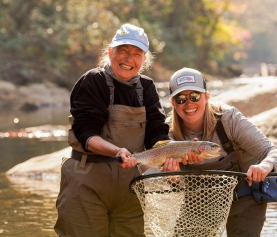Getting Knotty Part II
By popular demand, Kay DuShane is back and tying up a few loose ends. She’s getting even more knotty and teaching some additional knots that can be super useful.
Last time, we reviewed the two basic knots that CFR teaches at our retreats: the Clinch Knot to attach the fly to your tippet, and the Double Surgeon’s Knot used to attach tippet to your leader. Again, that’s all you need to know to fly fish independently.
But, if you have the desire to learn a couple more useful knots, I’d nominate the “Blood Knot,” which is used to attach more tippet and to build leaders, and some sort of a loop knot, to attach a fly.
The Blood knot is a truly beautiful knot – slim, symmetric, and useful. At first try, this knot can seem complicated and cumbersome, but once you tie it a few times, it’s worth having in your quiver. One of the benefits of a blood knot is that you don’t have to pull both tag ends through any loop, which can be helpful if you, for example, are fishing a two fly rig and don’t want to pull the flies through at times when you might want to re-tie the tippet knot. Additionally, if for any reason you reel it through your guides, it is smooth enough to not catch on any of them. Here are a couple of videos illustrating tying the Blood Knot:
Blood Knot Short Video HERE.
Blood Knot 30 Second Video HERE
To attach a fly, the next knot learned should be a loop knot, which allows the fly to have more natural movement in the water, especially with heavier tippets and streamer flies. A loop knot to attach a fly is generally reserved for larger, heavier flies, like streamers. It allows for a more natural motion in the water of streamers and saltwater flies. I have generally settled on a “perfection loop” knot to tie on flies with a loop knot, though a Non Slip Loop is certainly very popular with fly anglers, too. Here’s a video of tying a perfection loop:
Another bonus of knowing this knot is that you can tie the loop for the connection between your leader and fly line, if for whatever reason your leader isn’t pre-looped or you need to cut off your leader and reattach it.
Perfection Video HERE
Recently, this old dog has been using a new knot, the Davy Knot. I reserve it for really small flies and light tippets, exactly the type of flies we in Colorado must use in the winter to catch trout. I have been loving how small this knot appears, and how easy it is to tie. I also have used it when I want to size up my tippet a bit on smaller flies; for example, if I’m fishing a size 22 BWO imitation to bigger trout, I’ll cheat with a 5x tippet and use a Davy knot to attach the fly. It’s low profile allows the fly to move more naturally even with the tippet heavier than generally recommended for the fly.
Davy Video HERE.
So many knots work for fly anglers, in so many different conditions. And yes, you can do well with merely two knots for the rest of your fishing life. But, if you want to learn more knots, there are countless knots that could come in handy in different circumstances and are really fun to learn. Whatever knots you use most frequently, practice them enough to know what they should look like and to tie relatively quickly.

















